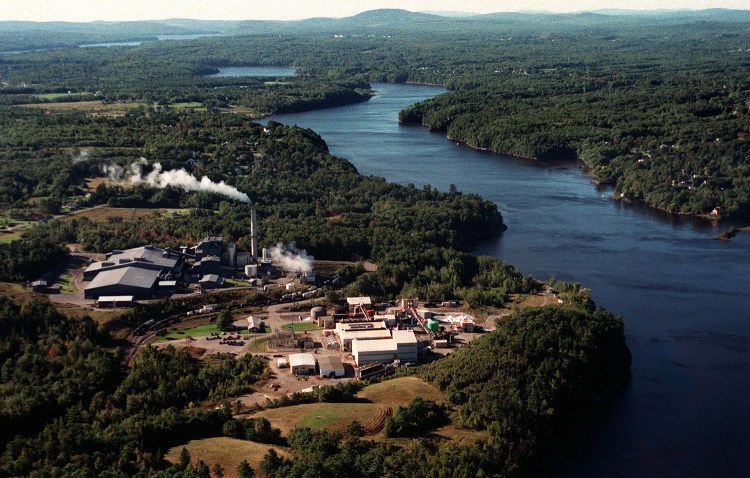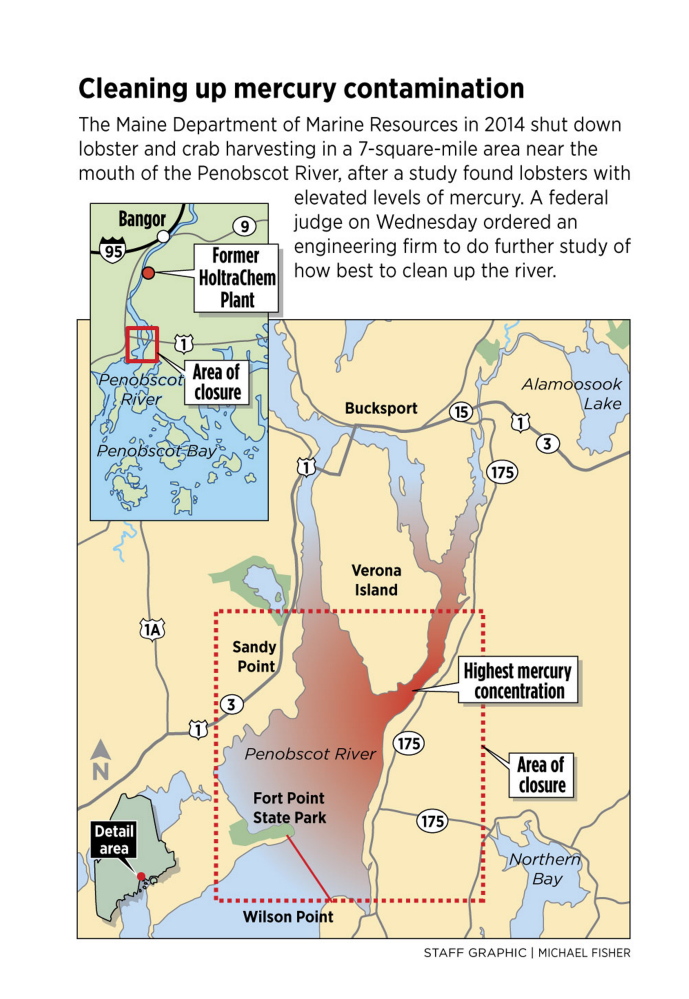A federal judge ordered Mallinckrodt US LLC on Wednesday to pay to develop a detailed plan to clean up mercury in the Penobscot River, potentially setting the stage for what would be one of the largest and costliest environmental remediation projects in Maine history.
In a ruling Wednesday, U.S. District Judge John Woodcock Jr. said an engineering firm will study the range, cost and practicality of removing the toxic heavy metal from the river bottom near Orrington down to the mouth of Penobscot Bay. Woodcock agreed with the two plaintiffs, the Maine People’s Alliance and the Natural Resources Defense Council, that the Penobscot estuary “continues to suffer irreparable harm from ongoing mercury contamination.”
The cost for cleaning up the contaminated riverbed south of the former HoltraChem site in Orrington has been pegged at $130 million.
“The court concludes that the plaintiffs have sustained their burden to justify a continuing injunction, one that mandates further study of the mercury contamination in the Penobscot River caused by Mallinckrodt,” wrote Woodcock, who held a three-week bench trial on the issue in June 2014. “More specifically, the plaintiffs have demonstrated it is essential for an engineering firm to investigate the current status of mercury contamination in the Penobscot River and to propose potential solutions to mitigate the current harm to the people, biota and environment of the Penobscot River estuary.”
Woodcock’s ruling is the latest twist in a legal battle stretching back more than a decade over who is responsible for tons of mercury that ended up in the Penobscot from the former HoltraChem industrial facility in Orrington.
While not the definitive cleanup order plaintiffs have been seeking since 1999, Woodcock’s decision was hailed as a milestone by a Maine People’s Alliance representative.
“It’s been a long time in the process, so we are excited that we have finally reached another milestone,” Jesse Graham, the group’s executive director, said Wednesday evening. “I think it is pretty definitive that they will have to pay to clean up the river, but we need the engineers to tell us how it should be done.”
YEARS OF DISCHARGE
Mallinckrodt, a St. Louis-based company, owned and operated the factory located on the banks of the Penobscot in Orrington from 1967 to 1982. The company, unbeknownst to state officials, discharged mercury directly into the river in the form of contaminated “brine sludge” at a rate of 1.5 to 2.5 pounds of mercury per day during the company’s initial ownership of the plant. While the amount of discharges declined after 1970, Mallinckrodt continued to send some of the heavy metal into the river through 1982, according to court documents.
A later operator, HoltraChem Manufacturing Co., shuttered the plant in 2000 and declared bankruptcy. But as the sole remaining former owner still in business, Mallinckrodt was deemed responsible for cleaning up the mercury that was used to manufacture chlorine bleach and other chemicals at the facility. Mallinckrodt is owned by the global health care company Medtronic.
The company has spent millions of dollars cleaning up the 235-acre facility site and millions more on the previous river study. The resulting report – running more than 1,800 pages – concluded that mercury was present in high concentrations in the Penobscot’s upper estuary as well as in sediments in the lower estuary. Mercury “bio-magnifies” in the food chain so that the potent neurotoxin accumulates in the bodies of species near the top of the predator pecking order, such as humans or eagles.
The contamination spread far enough into the estuaries along the river that scientists working for the federal court sought special permission to notify state officials in 2011 about dangerously high mercury levels found in black ducks, according to previous court records. The state responded by issuing a consumer warning and posting signs in Mendall Marsh telling women and children to avoid eating waterfowl from the area and for all others to limit how much they ate.
‘THE MERCURY HAS GOT TO GO’
Last year, the Maine Department of Marine Resources closed a 7-square-mile area at the mouth of the Penobscot River to lobster and crab harvesting for two years because of mercury contamination.
The report recommended removal of some mobile contaminated sediments and replacement with clean sediments as well as the use of a “binding agent” to reduce mercury levels. Though Mallinckrodt disputed the report’s findings and recommendations, the Maine People’s Alliance and the Natural Resources Defense Council said they didn’t go far enough.
During recent arguments, the parties agreed that hiring an engineering firm was a better option than a panel of engineers similar to the scientific panel that studied the contamination in the river for several years. However, Woodcock rejected Mallinckrodt’s contention that the company should take the lead in any further studies and remediation.
“The problem is public trust,” Woodcock wrote. “To entrust the cleanup to the polluter would be viewed as naive.”
Representatives for Mallinckrodt could not be reached for comment Wednesday night.
The plaintiffs in the case cheered the decision as another step toward restoring the river.
“After 40 years, Mallinckrodt finally has to clean up the mess they made,” Nancy Marks, senior attorney at the Natural Resources Defense Council, said in a statement. “The Penobscot River is getting a second chance. This is a relief for the people who eat its lobster, work its waters, treasure its wildlife, and live along its banks. It is justice for the Maine communities who suffered for too long at the hands of this powerful corporation. The court was clear: the contamination is severe and it is threatening people’s health. The mercury has got to go.”
It is uncertain when any cleanup of the river would take place. Woodcock wrote that he will appoint an engineering firm experienced with cleaning up mercury contamination “to develop cost-effective and effective remedies to clean up the remaining mercury” in the river. Both sides will have a chance to comment on and potentially dispute the resulting recommendations. Woodcock made clear, however, that Mallinckrodt will pay for the study.
Medtronic
Send questions/comments to the editors.





Success. Please wait for the page to reload. If the page does not reload within 5 seconds, please refresh the page.
Enter your email and password to access comments.
Hi, to comment on stories you must . This profile is in addition to your subscription and website login.
Already have a commenting profile? .
Invalid username/password.
Please check your email to confirm and complete your registration.
Only subscribers are eligible to post comments. Please subscribe or login first for digital access. Here’s why.
Use the form below to reset your password. When you've submitted your account email, we will send an email with a reset code.